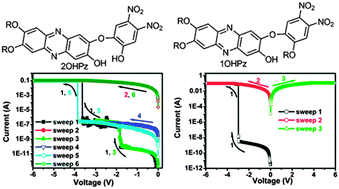The substituent group effect on the morphology and memory performance of phenazine derivatives†
Abstract
In this paper, we focused on how the film morphology changes can affect the memory performance based on phenazine derivatives because the performance of many devices is strongly dependent on the morphology of organic molecules in the as-prepared films. To address this point, two phenazine derivatives, 7,8-bis(decyloxy)-3-(2-hydroxy-4,5-dinitrophenoxy)phenazin-2-ol (2OHPz) and 7,8-bis(decyloxy)-3-(2-(decyloxy)-4,5-dinitrophenoxy)phenazin-2-ol (1OHPz), have been successfully synthesized and characterized. These two compounds have the same electron-withdrawing groups (nitro and pyrazine) and molecular backbone, but different terminal substituted groups, which would be very helpful for us to understand how substituted groups affect the morphology and device performance. In fact, the sandwich-structured memory devices based on ITO/2OHPz/Al exhibited excellent ternary memory behavior with high ON2/ON1/OFF current ratios of 108.8/103/1 at switching threshold voltages of −1.80 V/−3.62 V while the memory devices based on ITO/1OHPz/Al displayed binary memory behavior with ON/OFF current ratios of 107.5/1 at a switching threshold voltage of −3.0 V. The different memory behaviors are attributed to the different molecular packing in the two phenazine derivatives, which is confirmed by AFM, XRD and UV-vis absorption. The AFM height image of the 2OHPz film thermally evaporated onto the ITO surface indicates the formation of self-organized fibril structures, which is in sharp contrast to that of the 1OHPz film. This variation suggests different degrees of aggregation in these films, which is also in accordance with the XRD and UV-vis absorption results. There is one diffraction peak at 2θ 16.11° for the film of 2OHPz, indicating the formation of a more ordered structure in the thin film. In contrast, there is no obvious diffraction peak in the film of 1OHPz. Moreover, the UV-vis absorption wavelength of the thin film of 2OHPz is blue-shifted by ∼10 nm more than that of 1OHPz film compared to those in dichloromethane.


 Please wait while we load your content...
Please wait while we load your content...